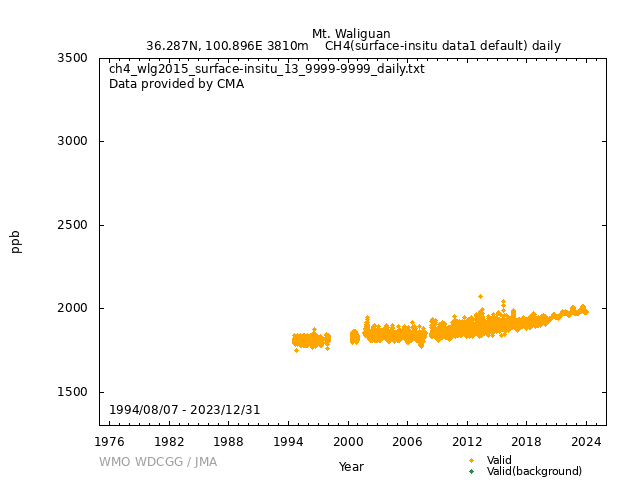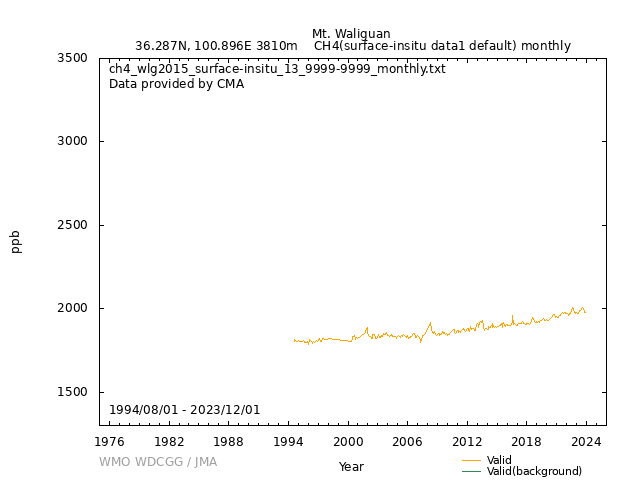Data Policy
GAW Data Policy
"For Scientific purposes, access to these data is unlimited and provided without charge.
By their use you accept that an offer of co-authorship will be made through personal contact with the data providers
or owners whenever substantial use is made of their data.
In all cases, an acknowledgement must be made to the data providers or owners and to the data centre when these data are used within a publication."
Version
2025-04-07-0857 (Last updated: 2025-04-28)File
This data set is submitted by CMA.
In line with the GAW Data Policy, users should contact the contributors of all data of interest and propose co-authorship or acknowledgement.
Organization
| NO | 13 |
|---|---|
| Acronym | CMA |
| Name | China Meteorological Administration |
| Address 1 | 46 Zhongguancun S. Ave., Haidian Dist., Beijing, 100081, China |
| Address 2 | |
| Address 3 | |
| Country/Territory | China |
| Website |
Contact(s)
| Name | LIANG Miao |
|---|---|
| Prefix | |
| liangm@cma.gov.cn | |
| Organization No | 13 |
| Organization acronym | CMA |
| Organization name | China Meteorological Administration |
| Organization country/territory | China |
| Address 1 | |
| Address 2 | |
| Address 3 | |
| Country/territory | China |
| Tel | |
| Fax | |
| Last updated date | 2025-04-07 |
| Background observation | |
| UTC | |
| ppb | |
|
9999-12-31 00:00:00 - 9999-12-31 23:59:59: WMO CH4 X2004 |
|
|
1994-07-01 00:00:00 - 2008-05-31 23:59:59: HP 5890 GC(Gas chromatography (FID)) 2008-06-01 00:00:00 - 2008-12-31 23:59:59: Aglient 6890 GC(Gas chromatography (FID)) 2009-01-01 00:00:00 - 2012-11-30 23:59:59: Picarro G1301(CRDS) 2012-12-01 00:00:00 - 2012-12-31 23:59:59: Aglient 6890 GC(Gas chromatography (FID)) 2013-01-01 00:00:00 - 2016-06-30 23:59:59: Picarro G1301(CRDS) 2016-07-01 00:00:00 - 9999-12-31 23:59:59: Picarro G2401(CRDS) |
|
|
9999-12-31 00:00:00 - 9999-12-31 23:59:59: 80 (m) |
|
| hourly | |
|
HP 5890 GC The standards of CH4 in clean dry air were used. The mole fraction is determined by the liner regression line determined every 35 minutes by two working standard gases that closely bracket the ambient mole fractions. The difference between the assigned mole fractions and the measured mole fractions is a measure of the overall system performance. Working standard gases are calibrated against primary standards. The working standard gases in the station are calibrated by the secondary standard gases before and after use (period of use is about 3-4 months). Aglient 6890 GC Two standards of CH4 in air were used. The mole fraction is determined by the liner regression line determined every 50 minutes by one working standard gas (WH) that is close to the ambient CH4 mole fractions. To the reference gas (Target), the difference between the assigned mole fractions and the measured mole fractions is a measure of the overall system performance. Picarro G1301 (CRDS) Three standards of CH4 in air were used. The mole fraction is determined by the liner regression line determined every 480 minutes by working high (WH) and working low (WL) standard gases. To the reference gas (Target), the differences between the assigned concentration and the measured mole fractions are used to evaluate the overall system performance. Picarro G2401 (CRDS) Two standards of CH4 in Air were used. The mole fraction is determined by the liner regression line determined every 360 minutes by working gas (W). To the reference gas (Target), the differences between the assigned concentration and the measured mole fractions are used to evaluate the overall system performance. |
|
|
GC-FID: Raw data from the GC-FID instrument is collected by the data acquisition system, and stored in the system as raw data. The raw data is converted to concentration data using calibration factors measured in the observation sequences. Ambient CH4 measurements are only included in the final data set if the re-evaluation of the second standard gas relative to the first standard is within 10 ppb of its assigned value and if the peak width for all injections is less than 0.015 min. The data out of this criterion are flagged by principal investigator, and which are deemed invalid. The data are also manually inspected and examined using quality control routines before being accepted as valid measurements. Picarro G1301 & 2401 (CRDS): The raw data from the Picarro G1301 is collected by the data acquisition system, and stored in the system as raw data. Every hour the data archive program grabs the latest 1 hour data and compress. Then transfer to CMA database for further processing. The raw data from the instrument is collected by the data acquisition system. Then it is identified by different gas streams and separated into 5 minutes cluster. The data processing routine dumps the first 3 minutes data and only uses the last 2 minutes average to calculate the concentration through the latest linearity regression factors. Invalid data caused by instrumental malfunction are checked with information from the station logbook. Ambient CH4 measurements are only included in the final data set if the re-evaluation of Target gas relative to the WH and WL is within 4 ppb of its assigned value. The data out of this criterion are flagged by principal investigator, and which are deemed invalid. The data are also manually inspected and examined using quality control routines before being accepted as valid measurements. The Agilent 6890N data are used to crosscheck the status of Picarro. In December, 2012, because of the malfunction of CRDS, the CH4 data are from Agilent 6890N GC. |
|
|
[Hourly] After computing the CH4 mole fractions, the valid data were manually inspected to eliminate the events which were influenced by analytical or sampling problems. Then the remainder of data were aggregated to hourly averages and were used for further processing. HP 5890GC & Aglient 6890GC: 1)Hourly averaged data was computed from without "flagged" event data within one hour measurements. Missing hourly data value default as "99999.999". 2)Hourly averaged data time series were selected using local surface wind direction and speed to distinguish samples of regionally representative air (background) from samples influenced by local sources and sinks (non-background). Using the statistic method, the acquired rate of the data which were categorized as background CH4 values ca 50%. Picarro G1301 & 2401 (CRDS): 1)Started from 2009, the CH4 data reported was mainly from CRDS. Some of the data gaps were synchronized and merged by the data from Agilent 6890 GC. 2)The data series was then filtered into "background" events considering with the meteorological conditions, data variations, etc. [Daily] The daily averages are based on only those hourly averages deemed to be "background" values. [Monthly] Monthly averages are computed from the daily averages. Missing daily averages are skipped. |
|
| Operational/Reporting | |
|
Wind direction: Wind speed: Relative humidity: Precipitation amount: Air pressure: Air temperature: Dew point temperature: Sea water temperature: Sea surface water temperature: Sea water salinity: Sea surface water salinity: |
|
|
Meteorological data may remain as first provided, even when greenhouse gas data are updated. |
No DOI available
Related information
GAW Data Policy
"For Scientific purposes, access to these data is unlimited and provided without charge.
By their use you accept that an offer of co-authorship will be made through personal contact with the data providers
or owners whenever substantial use is made of their data.
In all cases, an acknowledgement must be made to the data providers or owners and to the data centre when these data are used within a publication."
Citation format
This format is an example of the WDCGG standard citation.
Please follow the citation format which the data providers or owners indicate.
Please follow the citation format which the data providers or owners indicate.
LIANG Miao (CMA),
Atmospheric CH4
at Mt. Waliguan by China Meteorological Administration,
dataset published as CH4_WLG2015_surface-insitu_CMA_data1 at WDCGG,
ver. 2025-04-07-0857 (Reference date*: YYYY/MM/DD)
* As the reference date, please indicate the date you downloaded the files.
* As the reference date, please indicate the date you downloaded the files.
Reference(s)
| 1 | Zhou L. X., Worthy D. E. J., Lang P. M. et al.,(2004), Ten years of atmospheric methane observations at a high elevation site in Western China, Atmos. Environ., 38(40), 7041-7054. |
|---|---|
| 2 | Fang S. X., Zhou L. X., Masarie K. A., et al. (2013), Study of atmospheric CH4 mole fractions at three WMO/GAW stations in China, J. Geophys. Res., 118 (D10), 4874-4886. |
| 3 | S. X Fang, P. P. Tans, M. Steinbacher, et al. (2015), Study of the regional CO2 mole fractions filtering approach at a WMO/GAW regional station in China, Atmospheric Measurement Technique, 8, 5301-5313. |





